| View previous topic :: View next topic |
| Author |
Message |
Tracy

Joined: 15 Sep 2006
Posts: 551
Location: Toronto



|
 Posted: Sep 07, 2008 16:42 Post subject: Chinese cinnabar Posted: Sep 07, 2008 16:42 Post subject: Chinese cinnabar |
|
|
I've recently been looking at some images of beautiful cinnabar crystals (and have been enjoying a specimen I just acquired) and was curious to know how cinnabars from China compare in terms of overall quality to those from the classic localities? The Chinese specimens appear to have large gemmmy and well-formed crystals, are they considered to be of superior quality and if so why?
- Tracy
_________________
"Wisdom begins in wonder" - Socrates |
|
| Back to top |
|
 |
Jordi Fabre
Overall coordinator of the Forum

Joined: 07 Aug 2006
Posts: 5089
Location: Barcelona



|
 Posted: Sep 08, 2008 02:05 Post subject: Re: Chinese cinnabar Posted: Sep 08, 2008 02:05 Post subject: Re: Chinese cinnabar |
|
|
This is a very interesting topic as, for me, one of the main utilities of this forum should be to help people who's started recently to collect minerals, sharing with they the knowledge acquired after a long term experience.
On this case, it is hard to recognize the real quality of the Chinese Cinnabars if you don't lived on the ages where a 1 cm. dark, not so well formed, crystal of Cinnabar from Almadén (Spain) like this: https://www.fabreminerals.com/specimens/RSES-spain-notable-specimens.php#MJ96D8 was highly desired.
As far as I can remember only Almadén, Monte Amiata (Italy), Idria (Slovenia) and El Doctor (México) supplied the best Cinnabars to the market until the 90's when the Chinese Cinnabars arrived: https://www.fabreminerals.com/specimens/RSCN-china-notable-specimens.php#TF89H3
The Chinese Cinnabars came from different mines, them have different habits, their crystal size are much bigger than the previous one, their color is more red and intense, and them are more sharper too, so nothing to compare. Definitively the Chinese Cinnabars get the quality reference for this species and they stay.
Time to time this happens on mineralogy, a great classic like the Almadén Cinnabars fall down due the arrival of a supply from a new mine. Curiously it don't means necessarily that the value of the former ones fall down dramatically. Them kept their (more or less) value due its consolidated background and also to be still a reference for a certain locality.
A last comment about the Chinese Cinnabars, although they appeared on the market on the 90's their success just been consolidated on this century due the fact that the first ones gave a lot of money to the Chinese sellers and quickly they started to glue all crystals on matrix on its not original position, creating a kind of "art sculptures" that they do frequently with all kind of rocks, following his tradition.
Actually, they learned that this kind of "art sculptures" are not acceptable for occidental customers, so the main suppliers of Cinnabars stopped to do this and now they save the crystals sawing the matrix (the trimming of its Dolomite matrix is very complicated because frequently the crack lines pass thru the Cinnabar crystals) instead to glue them.
Jordi
| Description: |
An example of the superb Chinese Cinnabars. This one measure 8.3 × 6 × 2.7 cm. and the main crystal size is: 1.9 × 1.3 cm.
The specimen comes from Chatian, Fenghua, Hunan, China, and it was mined on 2004. The white matrix is Dolomite. |
|
| Viewed: |
29375 Time(s) |
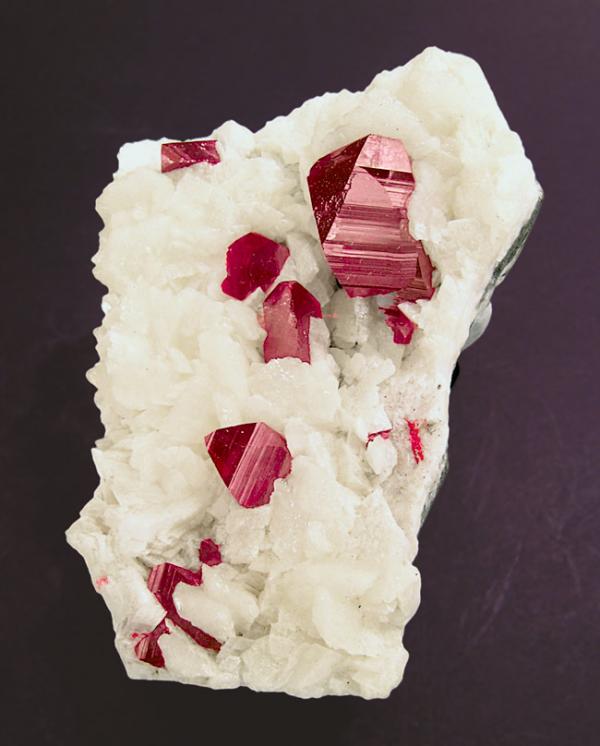
|
|
|
| Back to top |
|
 |
Druid

Joined: 24 Oct 2008
Posts: 9
Location: Cape Town


|
 Posted: Oct 24, 2008 04:59 Post subject: Re: Chinese cinnabar Posted: Oct 24, 2008 04:59 Post subject: Re: Chinese cinnabar |
|
|
i my self have a lovely specimen of Chinese Cinnabar. the one thing i have noticed with the Chinese crystals is that they are ofton very well formed with a lovely red colour and a realy cool metalic sheen to them.
i have seen some beautiful pictures in one of the Minerological Record magazines on Chinese minerals. I will see if i can find out what issue it was and get back to you.
_________________
Member of the South African Gem and Mineralogical Society |
|
| Back to top |
|
 |
Les Presmyk
Joined: 06 Dec 2007
Posts: 372
Location: Gilbert, AZ


|
 Posted: Oct 24, 2008 08:17 Post subject: Re: Chinese cinnabar Posted: Oct 24, 2008 08:17 Post subject: Re: Chinese cinnabar |
|
|
Chinese cinnabars have actually been coming out since at least the 1960's and have represented the world's finest. Jordi's comment about them coming out since the 1990's refers the period when the Chinese economy really began to expand and markets became open to both sellers and buyers. It is here we have seen the largest quantity and quality of material, much like many other minerals from there. It also means that specimens only the wealthiest of collectors could only dream about in the 1970's are now available and affordable by many more collectors. As a historical note, crystals were being glued onto the matrix in 1968 as well.
Certainly, the Spanish cinnabars are fine in their own right and still much desired. As are crystals from the New Almaden mine in California and the cinnabar crystals on stibnite from Alaska.
Tracy, just remember to keep the cinnabar in a box when you are note viewing it and it will remain this color forever.
|
|
| Back to top |
|
 |
parfaitelumiere
Joined: 02 Mar 2008
Posts: 153
Location: Auvergne



|
 Posted: Nov 01, 2008 08:03 Post subject: Re: Chinese cinnabar Posted: Nov 01, 2008 08:03 Post subject: Re: Chinese cinnabar |
|
|
I remember a specimen from a French museum.
It comes from china, with typical twinned crystals.
I have a typical specimen like this in my collection.
But nowadays we can find lots of other shapes, twinned or untwinned cristals, with very clear faces and intense red color, or near black color and gemmy red inside.
I have seen at Sainte Marie aux Mines a 12 cm piece with a 3 cm twinned cristal and some smaller ones, a 5cm quatz cristal and some dolomite cristals, not expensive, but, what a shame, the main cinnabar cristal was broken... arhhh!
So I bought this specimen:
| Description: |
| very little ,4 cm, but three cristals, the biggest 2 cm |
|
| Viewed: |
28644 Time(s) |
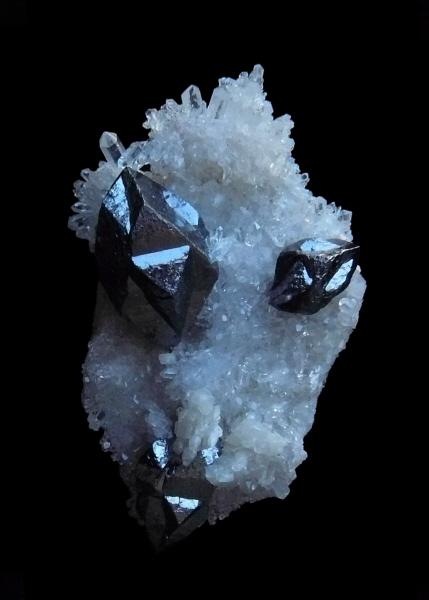
|
|
|
| Back to top |
|
 |
Mark Beregszaszi
Joined: 26 Dec 2013
Posts: 33
Location: Budapest


|
 Posted: Dec 26, 2013 21:18 Post subject: Re: Chinese cinnabar Posted: Dec 26, 2013 21:18 Post subject: Re: Chinese cinnabar |
|
|
The best Cinnabars I have seen so far in Hungary all came from China.
This is my piece:
| Description: |
Cinnabar
China
Bottom crystal is about 1,6cm high. |
|
| Viewed: |
25894 Time(s) |
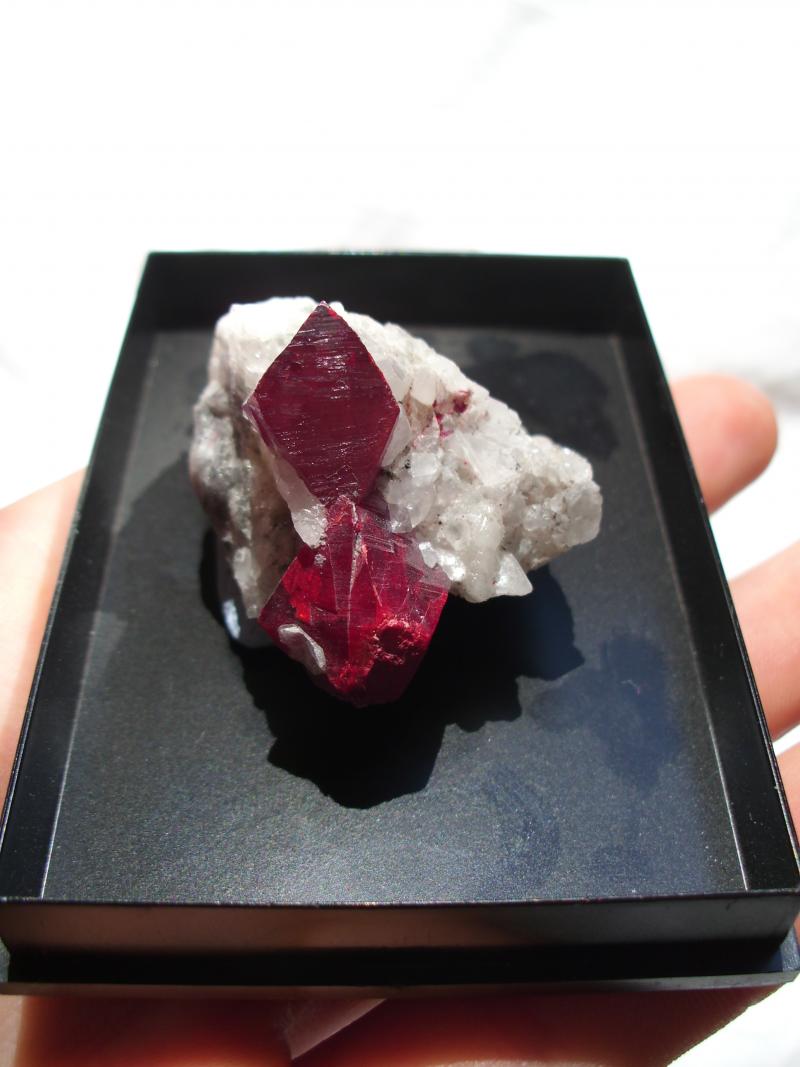
|
| Description: |
Cinnabar
China
Bottom crystal is about 1,6cm high. |
|
| Viewed: |
25881 Time(s) |
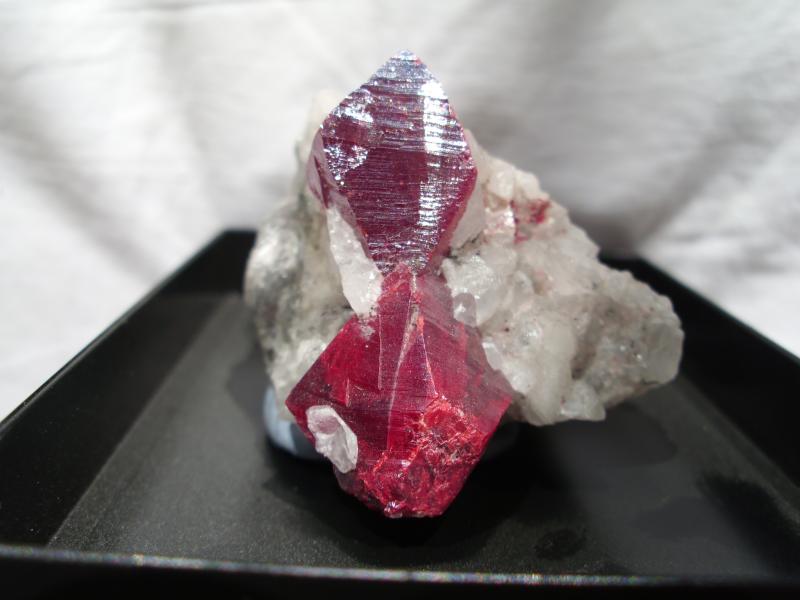
|
|
|
| Back to top |
|
 |
John Jaszczak

Joined: 05 Oct 2010
Posts: 300
Location: Hancock, MI



|
 Posted: Dec 29, 2013 15:06 Post subject: Re: Chinese cinnabar Posted: Dec 29, 2013 15:06 Post subject: Re: Chinese cinnabar |
|
|
Very early drawings of cinnabar crystals on matrix (two specimens) appear on a page of the table of contents of the Chinese Reorganized Pharmacopeia of 1249 A.D. by Thang Shen-Wei and Khou Tsung-Shih. The cinnabar was of interest as the elixir of immortality! It is unfortunate that the illustrations are not in color. In 712 A.D. Chhen Shao-Wei wrote,
"Now the highest grade, lustrous cinnabar, occurs in the mountains of Chen-Chou and Chin-Chou upon beds of white toothy mineral. [Mysterious Teachings on the Alchemical
Preparation of Numinous Cinnabar. Passage translated by N. Sivin in "Chinese Alchemy and the Manipulation of Time" Isis 67, 513 (1976)].
See Matrix vol. 1 no. 5 (1988) for reproductions of the page from the Reorganized Pharmacopeia.
_________________
Adjunct Curator, A. E. Seaman Mineral Museum
Professor of Physics
Michigan Technological University |
|
| Back to top |
|
 |
Mark Ost

Joined: 18 Mar 2013
Posts: 516
Location: Virginia Beach



|
 Posted: Dec 29, 2013 16:17 Post subject: Re: Chinese cinnabar Posted: Dec 29, 2013 16:17 Post subject: Re: Chinese cinnabar |
|
|
| Certainly from a historical perspective the Spanish cinnabars should hold value as the history of the mine is long and interesting. For that reason alone I would think that they are still desirable.
|
|
| Back to top |
|
 |
Roger Warin

Joined: 23 Jan 2013
Posts: 1246



|
 Posted: Dec 29, 2013 16:34 Post subject: Re: Chinese cinnabar Posted: Dec 29, 2013 16:34 Post subject: Re: Chinese cinnabar |
|
|
Hi,
Dr Rostenne (1942 - 2005) had a famous collection. Here is a cinnabar I shot for him.
From Hunan, China, without giving further details.
Roger.
| Description: |
Cinnabar
Hunan, China
25 mm high |
|
| Viewed: |
25655 Time(s) |
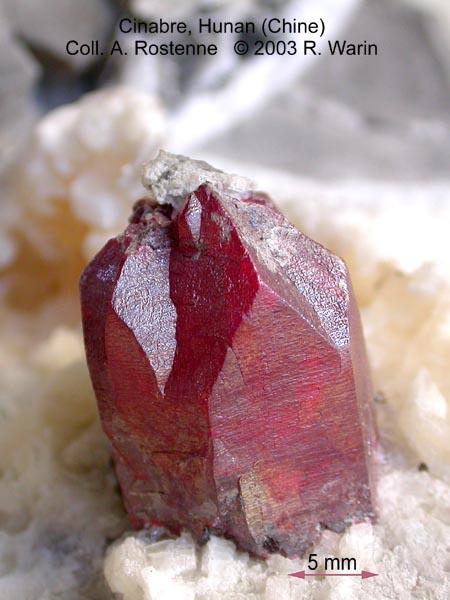
|
|
|
| Back to top |
|
 |
cascaillou
Joined: 27 Nov 2011
Posts: 263


|
 Posted: Dec 31, 2013 08:21 Post subject: Re: Chinese cinnabar Posted: Dec 31, 2013 08:21 Post subject: Re: Chinese cinnabar |
|
|
That is kind of another concern, but I was wondering:
It is my understanding that many native mercury specimens from spanish mines were actually artificially produced by heating cinnabar chunks till they would sweat some droplets of mercury, but unless I'm wrong native mercury droplets were also often naturally occuring in these mines.
What about the many chinese mines: any naturally occuring native mercury found there?
|
|
| Back to top |
|
 |
Rodney B Jackson
Joined: 13 Dec 2013
Posts: 12


|
 Posted: Dec 31, 2013 11:01 Post subject: Re: Chinese cinnabar Posted: Dec 31, 2013 11:01 Post subject: Re: Chinese cinnabar |
|
|
| The dolomite base realy sets it off. Great find.
|
|
| Back to top |
|
 |
Tracy

Joined: 15 Sep 2006
Posts: 551
Location: Toronto



|
 Posted: Jan 03, 2014 09:54 Post subject: Re: Chinese cinnabar Posted: Jan 03, 2014 09:54 Post subject: Re: Chinese cinnabar |
|
|
| cascaillou wrote: | That is kind of another concern, but I was wondering:
It is my understanding that many native mercury specimens from spanish mines were actually artificially produced by heating cinnabar chunks till they would sweat some droplets of mercury, but unless I'm wrong native mercury droplets were also often naturally occuring in these mines.
What about the many chinese mines: any naturally occuring native mercury found there? |
High Cascaillou - Happy 2014!
"Because cinnabar itself was used in early times and because mercury seldom leaves acrcheological traces, it is difficult to say when the Chinese first discovered mercury and began to use it...The connection between cinnabar and mercury was probably discovered rather easily since small globules of the native metal not infrequently accompany the ore. Moreover, blows from the miners' tools can cause cinnabar to shed tears of mercury."
(J. Needham, Science and Civilization in China. Vol. 13 Ch. 36a - Mining, by P.J. Golas; p. 139, Cinnabar and Mercury. Found on Google Books)
Cinnabar is the major ore of mercury and it is to be expected that mining of cinnabar would expose/release native mercury. I would also expect cinnabar and mercury to be found together most everywhere.
- Tracy
_________________
"Wisdom begins in wonder" - Socrates |
|
| Back to top |
|
 |
Roger Warin

Joined: 23 Jan 2013
Posts: 1246



|
 Posted: Jan 03, 2014 11:19 Post subject: Re: Chinese cinnabar Posted: Jan 03, 2014 11:19 Post subject: Re: Chinese cinnabar |
|
|
Hi,
The various phases of mercury sulfide are thermally unstable. It is therefore not surprising that mercury was known to the ancient Chinese, Egyptians and Hindus and has been found in Egyptian tombs dating back to about 1500 B.C.
Roger.
|
|
| Back to top |
|
 |
cascaillou
Joined: 27 Nov 2011
Posts: 263


|
 Posted: Jan 03, 2014 12:47 Post subject: Re: Chinese cinnabar Posted: Jan 03, 2014 12:47 Post subject: Re: Chinese cinnabar |
|
|
thank you for the imput
and happy 2014 !
|
|
| Back to top |
|
 |
kakov

Joined: 24 Jul 2013
Posts: 39
Location: Madrid



|
 Posted: Jan 04, 2014 06:20 Post subject: Re: cinnabar - collecting in Almadenejos Posted: Jan 04, 2014 06:20 Post subject: Re: cinnabar - collecting in Almadenejos |
|
|
| cascaillou wrote: |
It is my understanding that many native mercury specimens from spanish mines were actually artificially produced by heating cinnabar chunks till they would sweat some droplets of mercury, but unless I'm wrong native mercury droplets were also often naturally occuring in these mines.
|
I have never been myself to the historical Spanish mercury mines in Almadén en surroundings (Ciudad Real) but a friend of mine have been there and showed me the material he collected, it was full of mercury drops. He also told me that at the opening of a cavity FULL of mercury he grabbed with his hands and during some seconds had both palms full of the heavy liquid. I imagine it is not very healthy but must be an amazing experience!
I do not remember the exact year of his visit, we are talking about approx. 10-15 years ago; but surely it was not Almadén rather the nearby Almadenejos.
Anybody knows if it is still possible to visit and collect there?
|
|
| Back to top |
|
 |
|




